Analysis of Sunflower Company: Team Culture and Productivity
VerifiedAdded on 2023/06/11
|20
|4493
|141
Case Study
AI Summary
This case study analyzes Sunflower Food Company, a medium-sized bakery manufacturer, focusing on declining employee productivity due to internal culture, low staff morale, and motivation. The report provides recommendations to the CEO on establishing a team-based culture to improve morale and drive productivity. It identifies limitations in leadership among supervisors promoted from frontline positions, including lack of communication, unclear expectations, intimidation, and poor people skills. The analysis employs Lewin's Force Field Analysis Model, motivational theories, and concepts of organizational culture change to propose solutions such as improved communication, clear expectations, and fostering a positive work environment. The ultimate goal is to boost employee motivation, enhance company performance, and instill a sense of ownership and transparency within the organization.
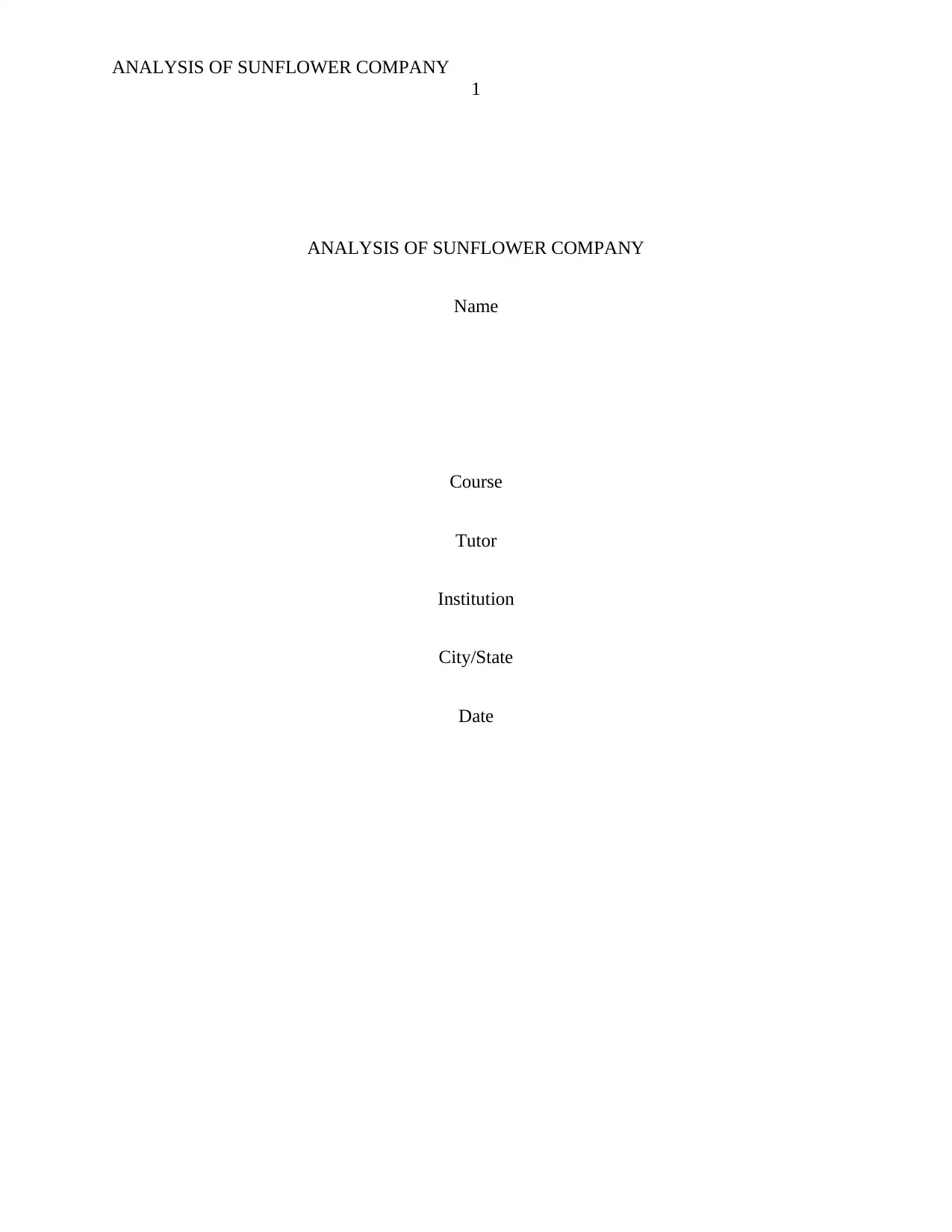
ANALYSIS OF SUNFLOWER COMPANY
1
ANALYSIS OF SUNFLOWER COMPANY
Name
Course
Tutor
Institution
City/State
Date
1
ANALYSIS OF SUNFLOWER COMPANY
Name
Course
Tutor
Institution
City/State
Date
Paraphrase This Document
Need a fresh take? Get an instant paraphrase of this document with our AI Paraphraser
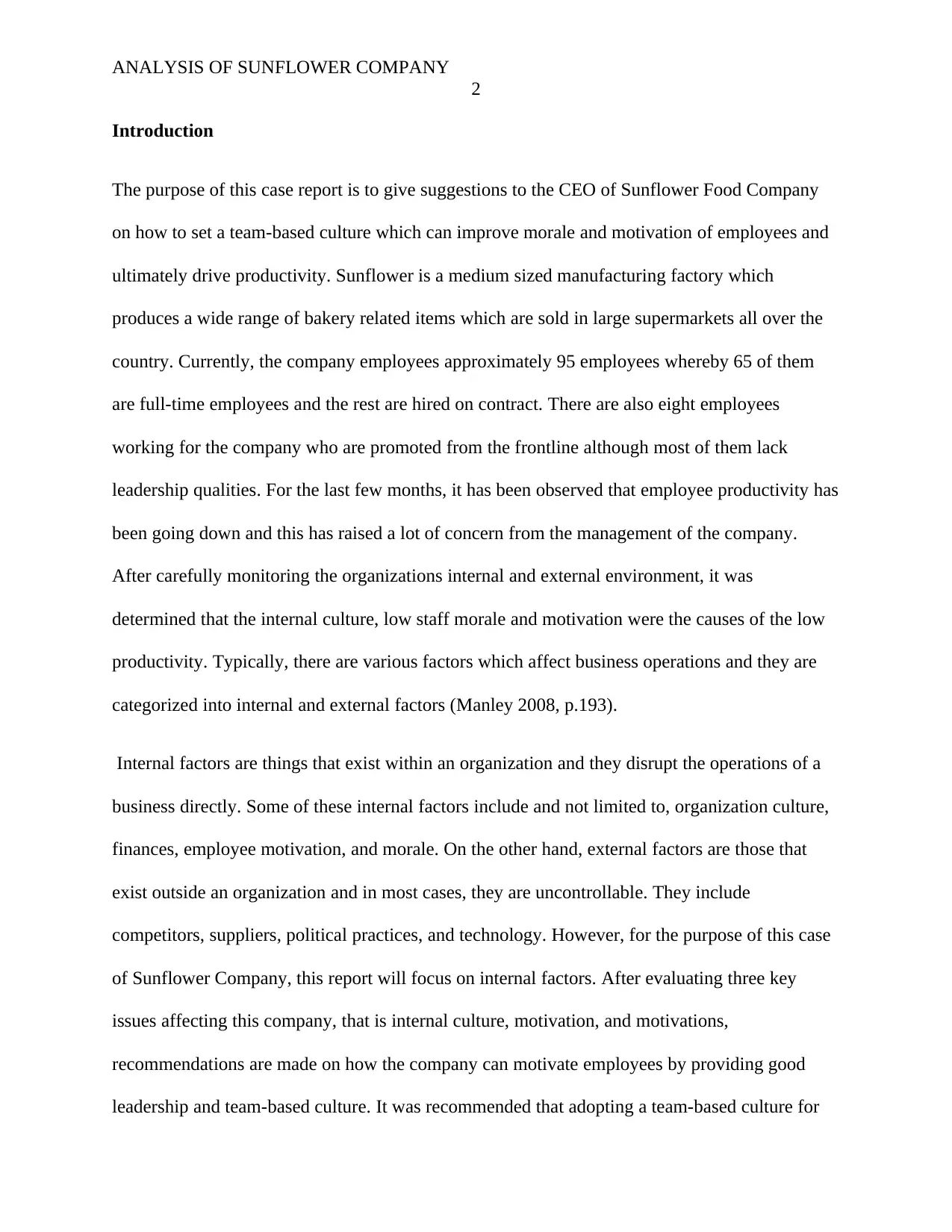
ANALYSIS OF SUNFLOWER COMPANY
2
Introduction
The purpose of this case report is to give suggestions to the CEO of Sunflower Food Company
on how to set a team-based culture which can improve morale and motivation of employees and
ultimately drive productivity. Sunflower is a medium sized manufacturing factory which
produces a wide range of bakery related items which are sold in large supermarkets all over the
country. Currently, the company employees approximately 95 employees whereby 65 of them
are full-time employees and the rest are hired on contract. There are also eight employees
working for the company who are promoted from the frontline although most of them lack
leadership qualities. For the last few months, it has been observed that employee productivity has
been going down and this has raised a lot of concern from the management of the company.
After carefully monitoring the organizations internal and external environment, it was
determined that the internal culture, low staff morale and motivation were the causes of the low
productivity. Typically, there are various factors which affect business operations and they are
categorized into internal and external factors (Manley 2008, p.193).
Internal factors are things that exist within an organization and they disrupt the operations of a
business directly. Some of these internal factors include and not limited to, organization culture,
finances, employee motivation, and morale. On the other hand, external factors are those that
exist outside an organization and in most cases, they are uncontrollable. They include
competitors, suppliers, political practices, and technology. However, for the purpose of this case
of Sunflower Company, this report will focus on internal factors. After evaluating three key
issues affecting this company, that is internal culture, motivation, and motivations,
recommendations are made on how the company can motivate employees by providing good
leadership and team-based culture. It was recommended that adopting a team-based culture for
2
Introduction
The purpose of this case report is to give suggestions to the CEO of Sunflower Food Company
on how to set a team-based culture which can improve morale and motivation of employees and
ultimately drive productivity. Sunflower is a medium sized manufacturing factory which
produces a wide range of bakery related items which are sold in large supermarkets all over the
country. Currently, the company employees approximately 95 employees whereby 65 of them
are full-time employees and the rest are hired on contract. There are also eight employees
working for the company who are promoted from the frontline although most of them lack
leadership qualities. For the last few months, it has been observed that employee productivity has
been going down and this has raised a lot of concern from the management of the company.
After carefully monitoring the organizations internal and external environment, it was
determined that the internal culture, low staff morale and motivation were the causes of the low
productivity. Typically, there are various factors which affect business operations and they are
categorized into internal and external factors (Manley 2008, p.193).
Internal factors are things that exist within an organization and they disrupt the operations of a
business directly. Some of these internal factors include and not limited to, organization culture,
finances, employee motivation, and morale. On the other hand, external factors are those that
exist outside an organization and in most cases, they are uncontrollable. They include
competitors, suppliers, political practices, and technology. However, for the purpose of this case
of Sunflower Company, this report will focus on internal factors. After evaluating three key
issues affecting this company, that is internal culture, motivation, and motivations,
recommendations are made on how the company can motivate employees by providing good
leadership and team-based culture. It was recommended that adopting a team-based culture for
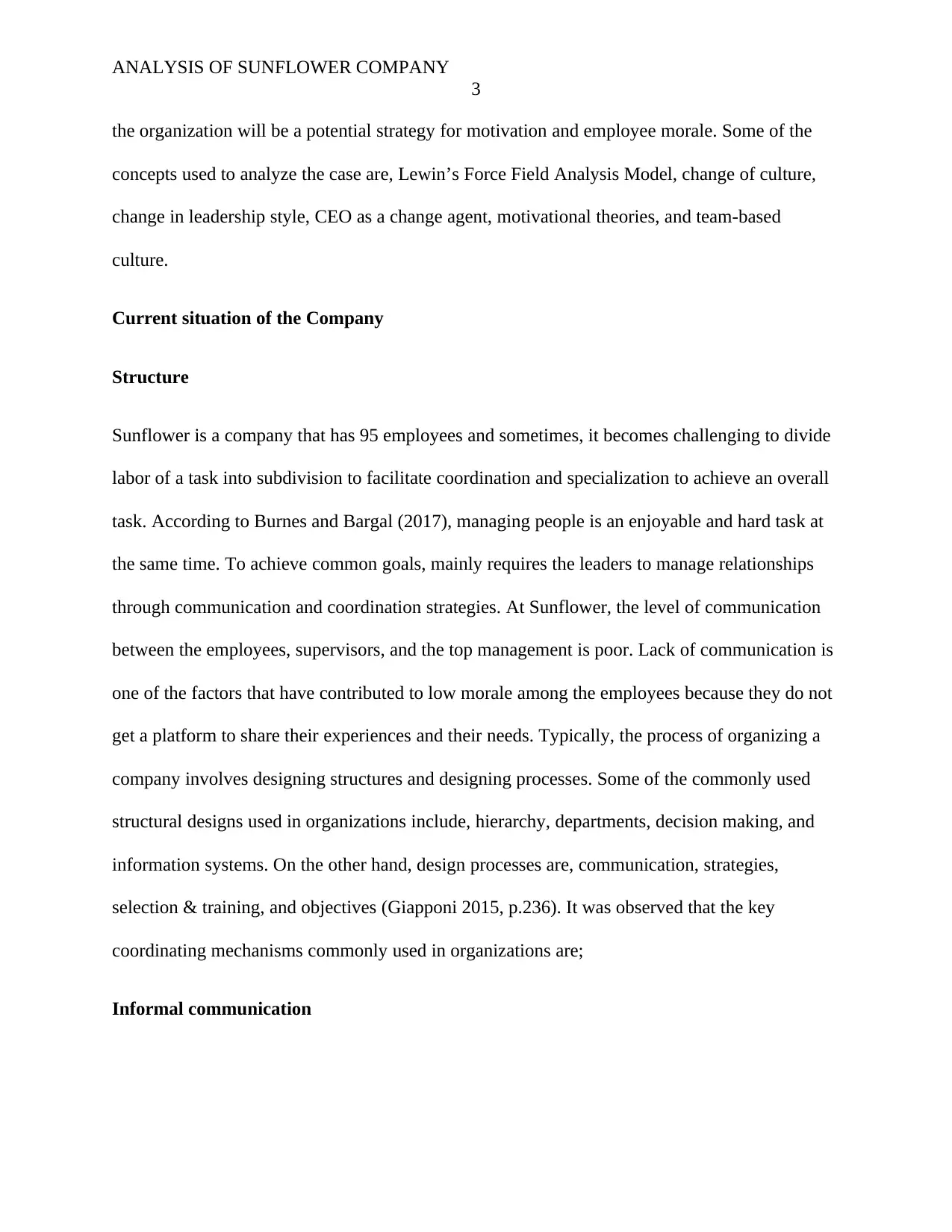
ANALYSIS OF SUNFLOWER COMPANY
3
the organization will be a potential strategy for motivation and employee morale. Some of the
concepts used to analyze the case are, Lewin’s Force Field Analysis Model, change of culture,
change in leadership style, CEO as a change agent, motivational theories, and team-based
culture.
Current situation of the Company
Structure
Sunflower is a company that has 95 employees and sometimes, it becomes challenging to divide
labor of a task into subdivision to facilitate coordination and specialization to achieve an overall
task. According to Burnes and Bargal (2017), managing people is an enjoyable and hard task at
the same time. To achieve common goals, mainly requires the leaders to manage relationships
through communication and coordination strategies. At Sunflower, the level of communication
between the employees, supervisors, and the top management is poor. Lack of communication is
one of the factors that have contributed to low morale among the employees because they do not
get a platform to share their experiences and their needs. Typically, the process of organizing a
company involves designing structures and designing processes. Some of the commonly used
structural designs used in organizations include, hierarchy, departments, decision making, and
information systems. On the other hand, design processes are, communication, strategies,
selection & training, and objectives (Giapponi 2015, p.236). It was observed that the key
coordinating mechanisms commonly used in organizations are;
Informal communication
3
the organization will be a potential strategy for motivation and employee morale. Some of the
concepts used to analyze the case are, Lewin’s Force Field Analysis Model, change of culture,
change in leadership style, CEO as a change agent, motivational theories, and team-based
culture.
Current situation of the Company
Structure
Sunflower is a company that has 95 employees and sometimes, it becomes challenging to divide
labor of a task into subdivision to facilitate coordination and specialization to achieve an overall
task. According to Burnes and Bargal (2017), managing people is an enjoyable and hard task at
the same time. To achieve common goals, mainly requires the leaders to manage relationships
through communication and coordination strategies. At Sunflower, the level of communication
between the employees, supervisors, and the top management is poor. Lack of communication is
one of the factors that have contributed to low morale among the employees because they do not
get a platform to share their experiences and their needs. Typically, the process of organizing a
company involves designing structures and designing processes. Some of the commonly used
structural designs used in organizations include, hierarchy, departments, decision making, and
information systems. On the other hand, design processes are, communication, strategies,
selection & training, and objectives (Giapponi 2015, p.236). It was observed that the key
coordinating mechanisms commonly used in organizations are;
Informal communication
⊘ This is a preview!⊘
Do you want full access?
Subscribe today to unlock all pages.

Trusted by 1+ million students worldwide
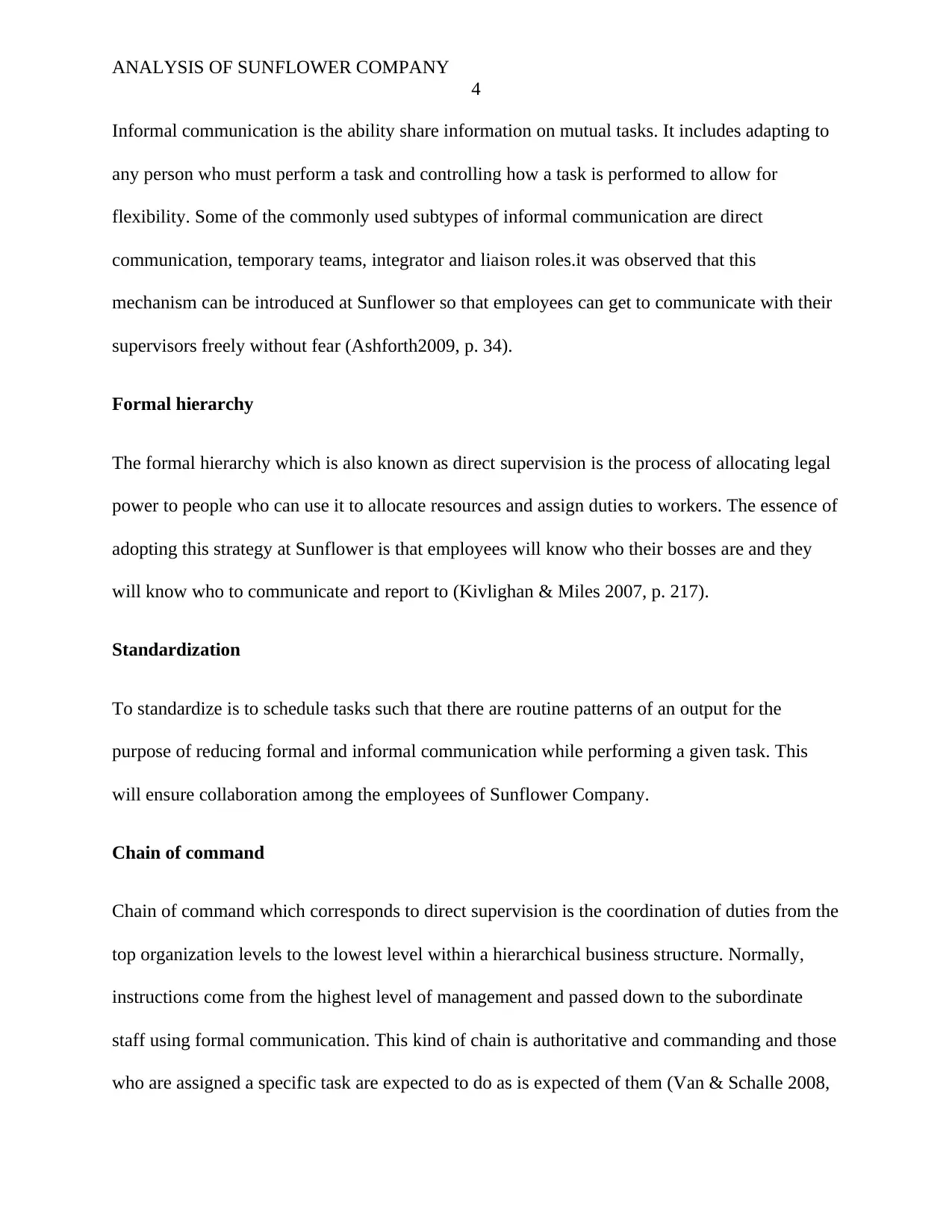
ANALYSIS OF SUNFLOWER COMPANY
4
Informal communication is the ability share information on mutual tasks. It includes adapting to
any person who must perform a task and controlling how a task is performed to allow for
flexibility. Some of the commonly used subtypes of informal communication are direct
communication, temporary teams, integrator and liaison roles.it was observed that this
mechanism can be introduced at Sunflower so that employees can get to communicate with their
supervisors freely without fear (Ashforth2009, p. 34).
Formal hierarchy
The formal hierarchy which is also known as direct supervision is the process of allocating legal
power to people who can use it to allocate resources and assign duties to workers. The essence of
adopting this strategy at Sunflower is that employees will know who their bosses are and they
will know who to communicate and report to (Kivlighan & Miles 2007, p. 217).
Standardization
To standardize is to schedule tasks such that there are routine patterns of an output for the
purpose of reducing formal and informal communication while performing a given task. This
will ensure collaboration among the employees of Sunflower Company.
Chain of command
Chain of command which corresponds to direct supervision is the coordination of duties from the
top organization levels to the lowest level within a hierarchical business structure. Normally,
instructions come from the highest level of management and passed down to the subordinate
staff using formal communication. This kind of chain is authoritative and commanding and those
who are assigned a specific task are expected to do as is expected of them (Van & Schalle 2008,
4
Informal communication is the ability share information on mutual tasks. It includes adapting to
any person who must perform a task and controlling how a task is performed to allow for
flexibility. Some of the commonly used subtypes of informal communication are direct
communication, temporary teams, integrator and liaison roles.it was observed that this
mechanism can be introduced at Sunflower so that employees can get to communicate with their
supervisors freely without fear (Ashforth2009, p. 34).
Formal hierarchy
The formal hierarchy which is also known as direct supervision is the process of allocating legal
power to people who can use it to allocate resources and assign duties to workers. The essence of
adopting this strategy at Sunflower is that employees will know who their bosses are and they
will know who to communicate and report to (Kivlighan & Miles 2007, p. 217).
Standardization
To standardize is to schedule tasks such that there are routine patterns of an output for the
purpose of reducing formal and informal communication while performing a given task. This
will ensure collaboration among the employees of Sunflower Company.
Chain of command
Chain of command which corresponds to direct supervision is the coordination of duties from the
top organization levels to the lowest level within a hierarchical business structure. Normally,
instructions come from the highest level of management and passed down to the subordinate
staff using formal communication. This kind of chain is authoritative and commanding and those
who are assigned a specific task are expected to do as is expected of them (Van & Schalle 2008,
Paraphrase This Document
Need a fresh take? Get an instant paraphrase of this document with our AI Paraphraser
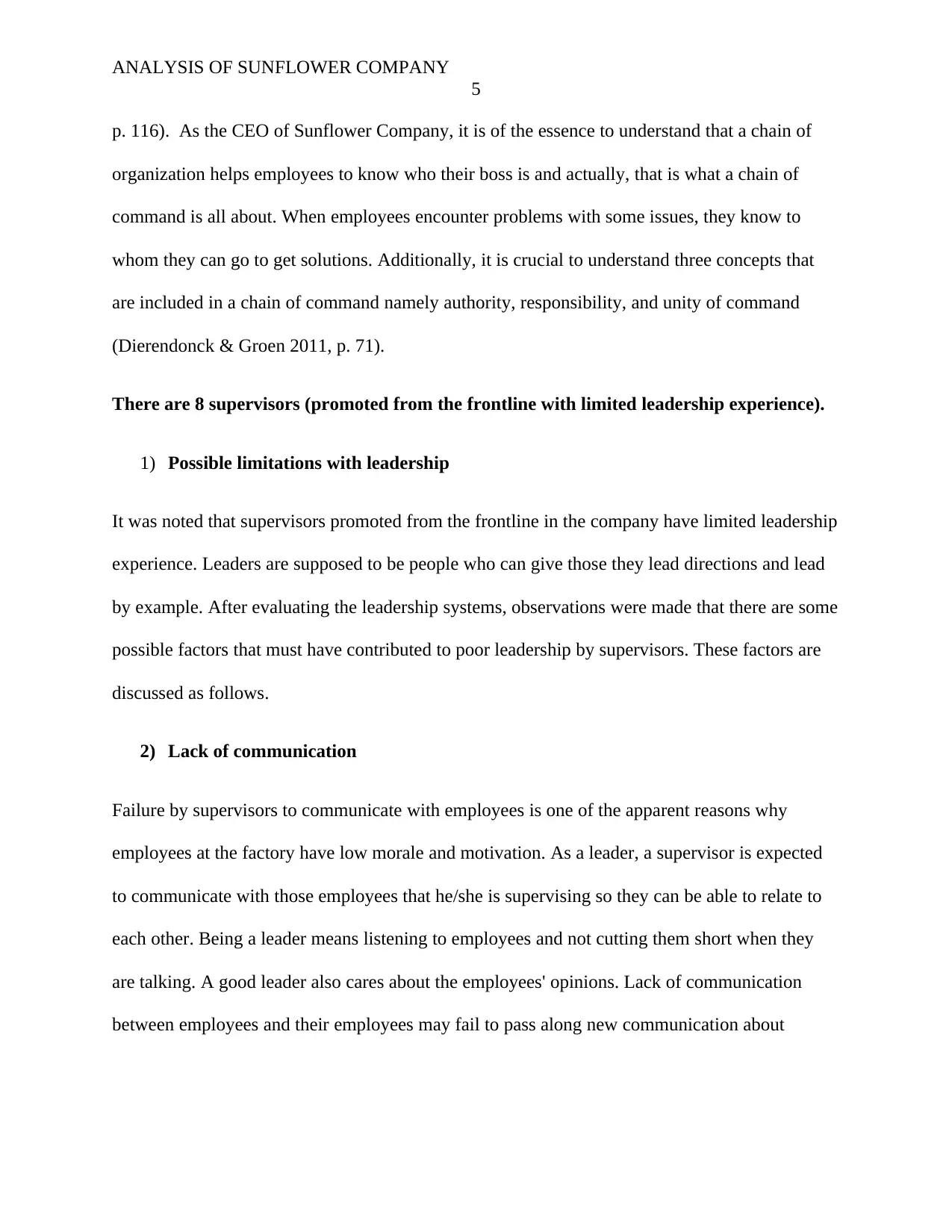
ANALYSIS OF SUNFLOWER COMPANY
5
p. 116). As the CEO of Sunflower Company, it is of the essence to understand that a chain of
organization helps employees to know who their boss is and actually, that is what a chain of
command is all about. When employees encounter problems with some issues, they know to
whom they can go to get solutions. Additionally, it is crucial to understand three concepts that
are included in a chain of command namely authority, responsibility, and unity of command
(Dierendonck & Groen 2011, p. 71).
There are 8 supervisors (promoted from the frontline with limited leadership experience).
1) Possible limitations with leadership
It was noted that supervisors promoted from the frontline in the company have limited leadership
experience. Leaders are supposed to be people who can give those they lead directions and lead
by example. After evaluating the leadership systems, observations were made that there are some
possible factors that must have contributed to poor leadership by supervisors. These factors are
discussed as follows.
2) Lack of communication
Failure by supervisors to communicate with employees is one of the apparent reasons why
employees at the factory have low morale and motivation. As a leader, a supervisor is expected
to communicate with those employees that he/she is supervising so they can be able to relate to
each other. Being a leader means listening to employees and not cutting them short when they
are talking. A good leader also cares about the employees' opinions. Lack of communication
between employees and their employees may fail to pass along new communication about
5
p. 116). As the CEO of Sunflower Company, it is of the essence to understand that a chain of
organization helps employees to know who their boss is and actually, that is what a chain of
command is all about. When employees encounter problems with some issues, they know to
whom they can go to get solutions. Additionally, it is crucial to understand three concepts that
are included in a chain of command namely authority, responsibility, and unity of command
(Dierendonck & Groen 2011, p. 71).
There are 8 supervisors (promoted from the frontline with limited leadership experience).
1) Possible limitations with leadership
It was noted that supervisors promoted from the frontline in the company have limited leadership
experience. Leaders are supposed to be people who can give those they lead directions and lead
by example. After evaluating the leadership systems, observations were made that there are some
possible factors that must have contributed to poor leadership by supervisors. These factors are
discussed as follows.
2) Lack of communication
Failure by supervisors to communicate with employees is one of the apparent reasons why
employees at the factory have low morale and motivation. As a leader, a supervisor is expected
to communicate with those employees that he/she is supervising so they can be able to relate to
each other. Being a leader means listening to employees and not cutting them short when they
are talking. A good leader also cares about the employees' opinions. Lack of communication
between employees and their employees may fail to pass along new communication about
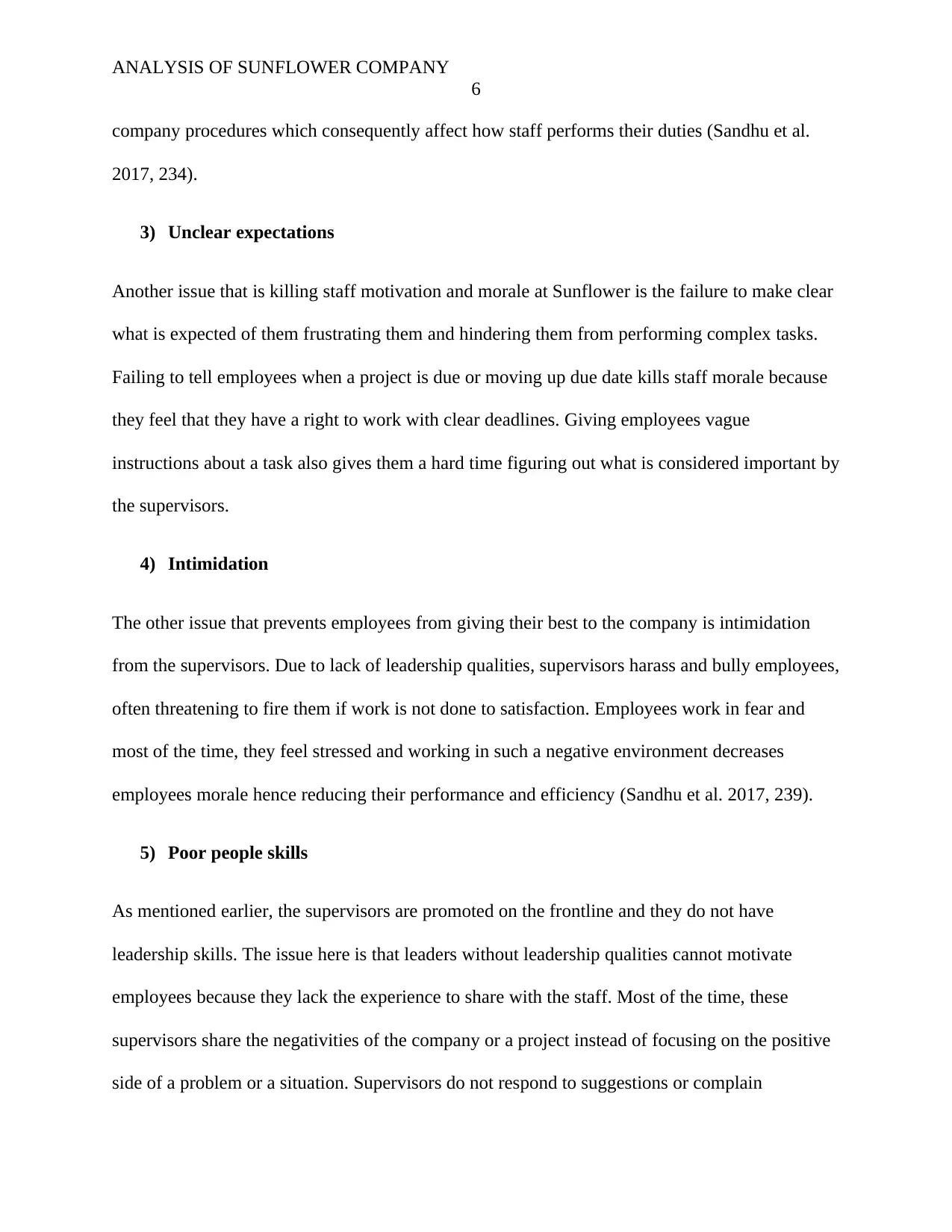
ANALYSIS OF SUNFLOWER COMPANY
6
company procedures which consequently affect how staff performs their duties (Sandhu et al.
2017, 234).
3) Unclear expectations
Another issue that is killing staff motivation and morale at Sunflower is the failure to make clear
what is expected of them frustrating them and hindering them from performing complex tasks.
Failing to tell employees when a project is due or moving up due date kills staff morale because
they feel that they have a right to work with clear deadlines. Giving employees vague
instructions about a task also gives them a hard time figuring out what is considered important by
the supervisors.
4) Intimidation
The other issue that prevents employees from giving their best to the company is intimidation
from the supervisors. Due to lack of leadership qualities, supervisors harass and bully employees,
often threatening to fire them if work is not done to satisfaction. Employees work in fear and
most of the time, they feel stressed and working in such a negative environment decreases
employees morale hence reducing their performance and efficiency (Sandhu et al. 2017, 239).
5) Poor people skills
As mentioned earlier, the supervisors are promoted on the frontline and they do not have
leadership skills. The issue here is that leaders without leadership qualities cannot motivate
employees because they lack the experience to share with the staff. Most of the time, these
supervisors share the negativities of the company or a project instead of focusing on the positive
side of a problem or a situation. Supervisors do not respond to suggestions or complain
6
company procedures which consequently affect how staff performs their duties (Sandhu et al.
2017, 234).
3) Unclear expectations
Another issue that is killing staff motivation and morale at Sunflower is the failure to make clear
what is expected of them frustrating them and hindering them from performing complex tasks.
Failing to tell employees when a project is due or moving up due date kills staff morale because
they feel that they have a right to work with clear deadlines. Giving employees vague
instructions about a task also gives them a hard time figuring out what is considered important by
the supervisors.
4) Intimidation
The other issue that prevents employees from giving their best to the company is intimidation
from the supervisors. Due to lack of leadership qualities, supervisors harass and bully employees,
often threatening to fire them if work is not done to satisfaction. Employees work in fear and
most of the time, they feel stressed and working in such a negative environment decreases
employees morale hence reducing their performance and efficiency (Sandhu et al. 2017, 239).
5) Poor people skills
As mentioned earlier, the supervisors are promoted on the frontline and they do not have
leadership skills. The issue here is that leaders without leadership qualities cannot motivate
employees because they lack the experience to share with the staff. Most of the time, these
supervisors share the negativities of the company or a project instead of focusing on the positive
side of a problem or a situation. Supervisors do not respond to suggestions or complain
⊘ This is a preview!⊘
Do you want full access?
Subscribe today to unlock all pages.

Trusted by 1+ million students worldwide
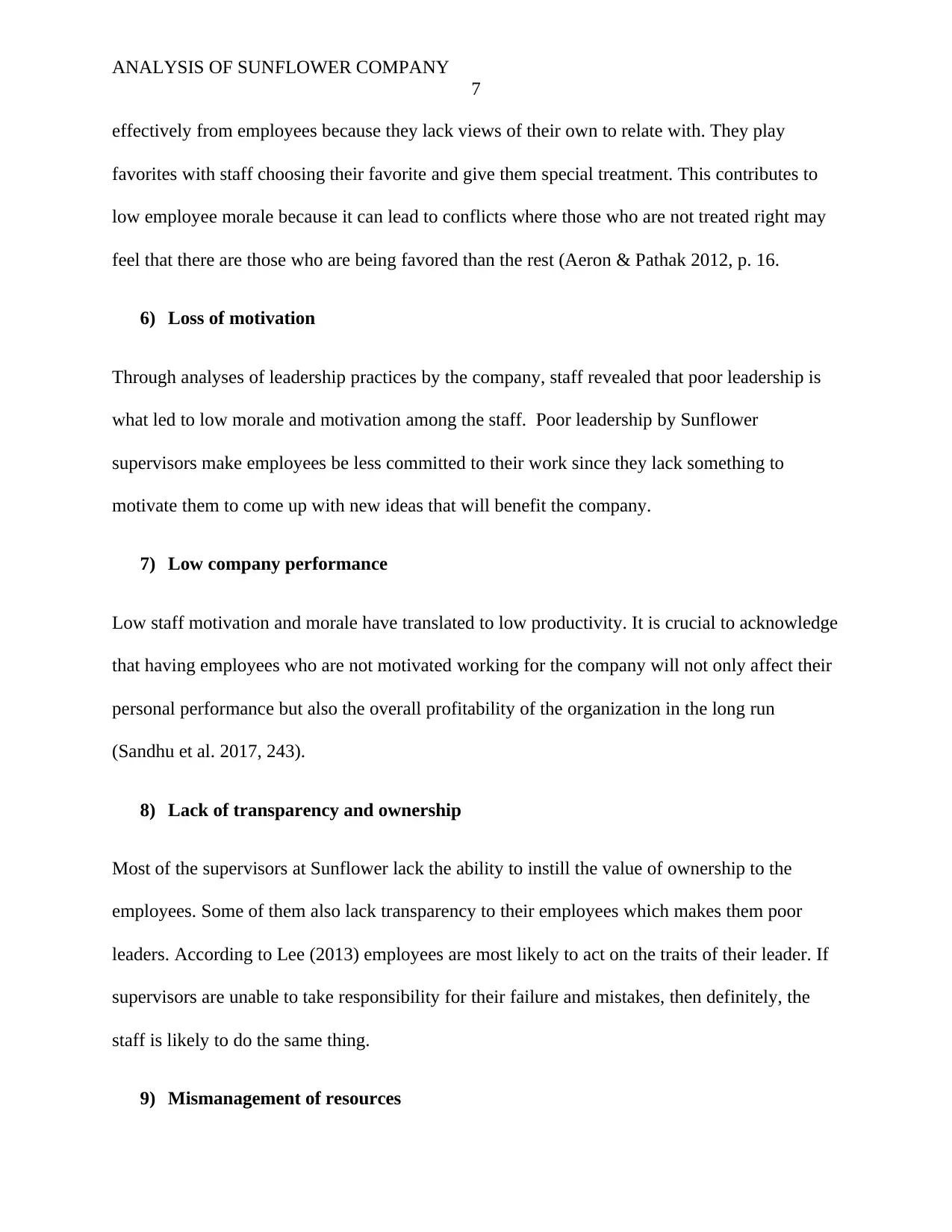
ANALYSIS OF SUNFLOWER COMPANY
7
effectively from employees because they lack views of their own to relate with. They play
favorites with staff choosing their favorite and give them special treatment. This contributes to
low employee morale because it can lead to conflicts where those who are not treated right may
feel that there are those who are being favored than the rest (Aeron & Pathak 2012, p. 16.
6) Loss of motivation
Through analyses of leadership practices by the company, staff revealed that poor leadership is
what led to low morale and motivation among the staff. Poor leadership by Sunflower
supervisors make employees be less committed to their work since they lack something to
motivate them to come up with new ideas that will benefit the company.
7) Low company performance
Low staff motivation and morale have translated to low productivity. It is crucial to acknowledge
that having employees who are not motivated working for the company will not only affect their
personal performance but also the overall profitability of the organization in the long run
(Sandhu et al. 2017, 243).
8) Lack of transparency and ownership
Most of the supervisors at Sunflower lack the ability to instill the value of ownership to the
employees. Some of them also lack transparency to their employees which makes them poor
leaders. According to Lee (2013) employees are most likely to act on the traits of their leader. If
supervisors are unable to take responsibility for their failure and mistakes, then definitely, the
staff is likely to do the same thing.
9) Mismanagement of resources
7
effectively from employees because they lack views of their own to relate with. They play
favorites with staff choosing their favorite and give them special treatment. This contributes to
low employee morale because it can lead to conflicts where those who are not treated right may
feel that there are those who are being favored than the rest (Aeron & Pathak 2012, p. 16.
6) Loss of motivation
Through analyses of leadership practices by the company, staff revealed that poor leadership is
what led to low morale and motivation among the staff. Poor leadership by Sunflower
supervisors make employees be less committed to their work since they lack something to
motivate them to come up with new ideas that will benefit the company.
7) Low company performance
Low staff motivation and morale have translated to low productivity. It is crucial to acknowledge
that having employees who are not motivated working for the company will not only affect their
personal performance but also the overall profitability of the organization in the long run
(Sandhu et al. 2017, 243).
8) Lack of transparency and ownership
Most of the supervisors at Sunflower lack the ability to instill the value of ownership to the
employees. Some of them also lack transparency to their employees which makes them poor
leaders. According to Lee (2013) employees are most likely to act on the traits of their leader. If
supervisors are unable to take responsibility for their failure and mistakes, then definitely, the
staff is likely to do the same thing.
9) Mismanagement of resources
Paraphrase This Document
Need a fresh take? Get an instant paraphrase of this document with our AI Paraphraser
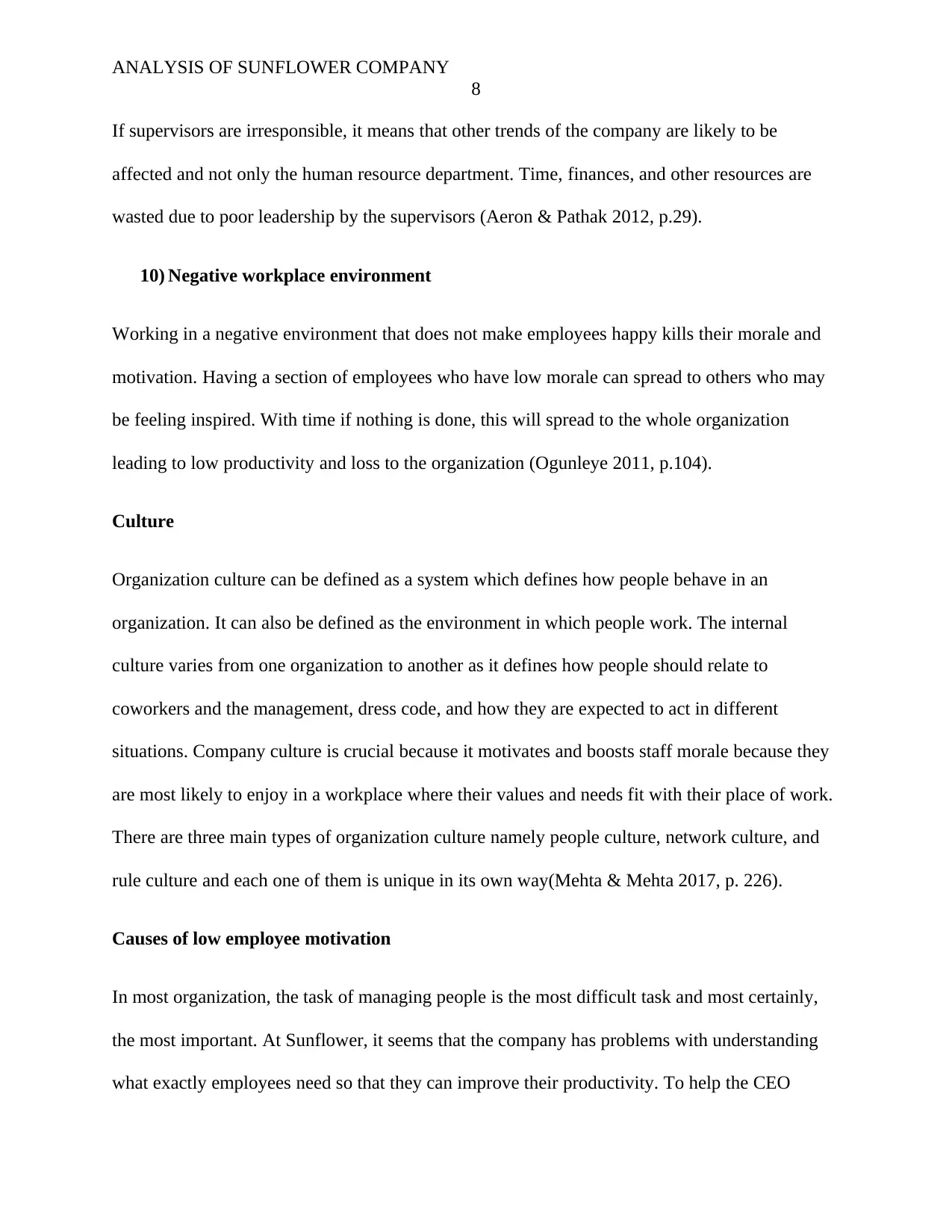
ANALYSIS OF SUNFLOWER COMPANY
8
If supervisors are irresponsible, it means that other trends of the company are likely to be
affected and not only the human resource department. Time, finances, and other resources are
wasted due to poor leadership by the supervisors (Aeron & Pathak 2012, p.29).
10) Negative workplace environment
Working in a negative environment that does not make employees happy kills their morale and
motivation. Having a section of employees who have low morale can spread to others who may
be feeling inspired. With time if nothing is done, this will spread to the whole organization
leading to low productivity and loss to the organization (Ogunleye 2011, p.104).
Culture
Organization culture can be defined as a system which defines how people behave in an
organization. It can also be defined as the environment in which people work. The internal
culture varies from one organization to another as it defines how people should relate to
coworkers and the management, dress code, and how they are expected to act in different
situations. Company culture is crucial because it motivates and boosts staff morale because they
are most likely to enjoy in a workplace where their values and needs fit with their place of work.
There are three main types of organization culture namely people culture, network culture, and
rule culture and each one of them is unique in its own way(Mehta & Mehta 2017, p. 226).
Causes of low employee motivation
In most organization, the task of managing people is the most difficult task and most certainly,
the most important. At Sunflower, it seems that the company has problems with understanding
what exactly employees need so that they can improve their productivity. To help the CEO
8
If supervisors are irresponsible, it means that other trends of the company are likely to be
affected and not only the human resource department. Time, finances, and other resources are
wasted due to poor leadership by the supervisors (Aeron & Pathak 2012, p.29).
10) Negative workplace environment
Working in a negative environment that does not make employees happy kills their morale and
motivation. Having a section of employees who have low morale can spread to others who may
be feeling inspired. With time if nothing is done, this will spread to the whole organization
leading to low productivity and loss to the organization (Ogunleye 2011, p.104).
Culture
Organization culture can be defined as a system which defines how people behave in an
organization. It can also be defined as the environment in which people work. The internal
culture varies from one organization to another as it defines how people should relate to
coworkers and the management, dress code, and how they are expected to act in different
situations. Company culture is crucial because it motivates and boosts staff morale because they
are most likely to enjoy in a workplace where their values and needs fit with their place of work.
There are three main types of organization culture namely people culture, network culture, and
rule culture and each one of them is unique in its own way(Mehta & Mehta 2017, p. 226).
Causes of low employee motivation
In most organization, the task of managing people is the most difficult task and most certainly,
the most important. At Sunflower, it seems that the company has problems with understanding
what exactly employees need so that they can improve their productivity. To help the CEO
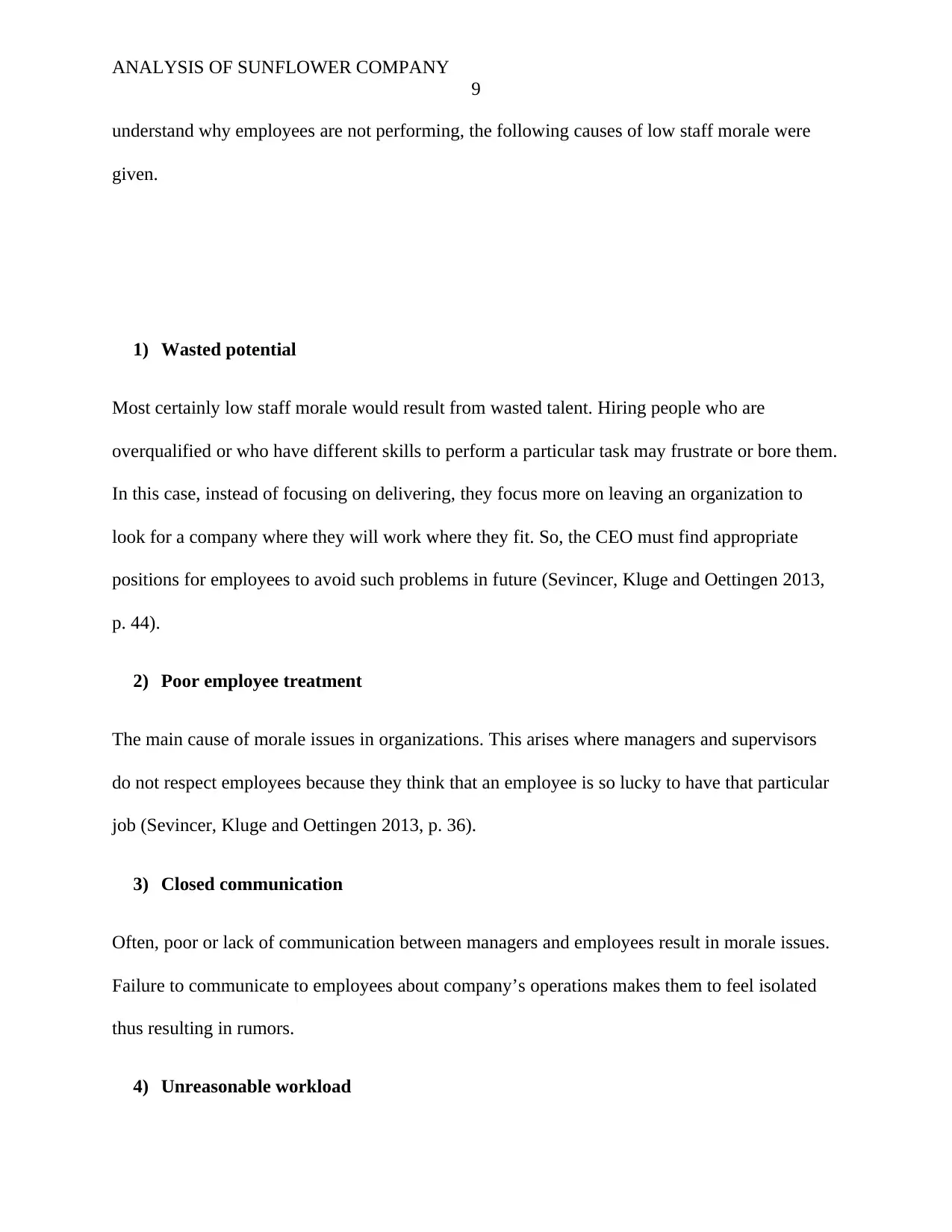
ANALYSIS OF SUNFLOWER COMPANY
9
understand why employees are not performing, the following causes of low staff morale were
given.
1) Wasted potential
Most certainly low staff morale would result from wasted talent. Hiring people who are
overqualified or who have different skills to perform a particular task may frustrate or bore them.
In this case, instead of focusing on delivering, they focus more on leaving an organization to
look for a company where they will work where they fit. So, the CEO must find appropriate
positions for employees to avoid such problems in future (Sevincer, Kluge and Oettingen 2013,
p. 44).
2) Poor employee treatment
The main cause of morale issues in organizations. This arises where managers and supervisors
do not respect employees because they think that an employee is so lucky to have that particular
job (Sevincer, Kluge and Oettingen 2013, p. 36).
3) Closed communication
Often, poor or lack of communication between managers and employees result in morale issues.
Failure to communicate to employees about company’s operations makes them to feel isolated
thus resulting in rumors.
4) Unreasonable workload
9
understand why employees are not performing, the following causes of low staff morale were
given.
1) Wasted potential
Most certainly low staff morale would result from wasted talent. Hiring people who are
overqualified or who have different skills to perform a particular task may frustrate or bore them.
In this case, instead of focusing on delivering, they focus more on leaving an organization to
look for a company where they will work where they fit. So, the CEO must find appropriate
positions for employees to avoid such problems in future (Sevincer, Kluge and Oettingen 2013,
p. 44).
2) Poor employee treatment
The main cause of morale issues in organizations. This arises where managers and supervisors
do not respect employees because they think that an employee is so lucky to have that particular
job (Sevincer, Kluge and Oettingen 2013, p. 36).
3) Closed communication
Often, poor or lack of communication between managers and employees result in morale issues.
Failure to communicate to employees about company’s operations makes them to feel isolated
thus resulting in rumors.
4) Unreasonable workload
⊘ This is a preview!⊘
Do you want full access?
Subscribe today to unlock all pages.

Trusted by 1+ million students worldwide
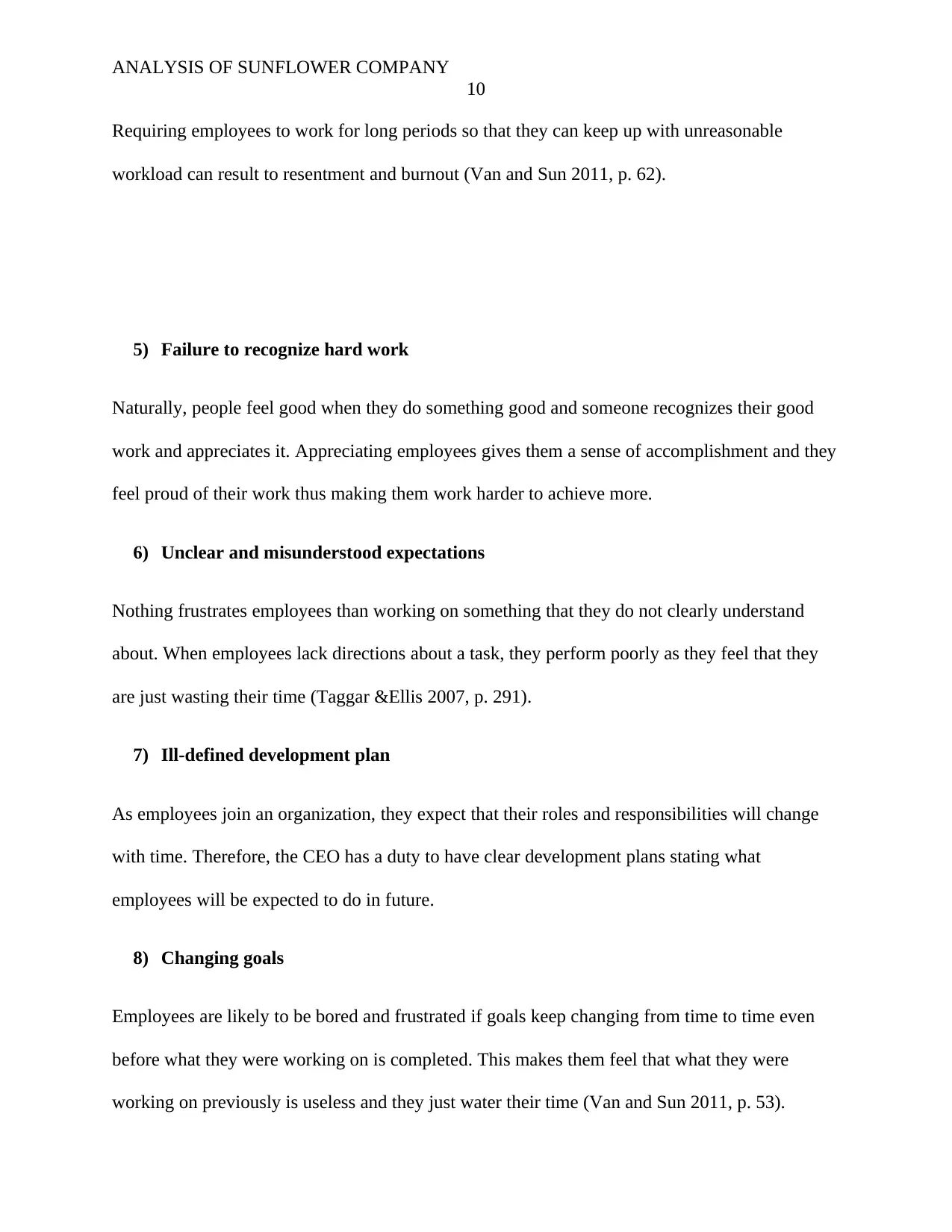
ANALYSIS OF SUNFLOWER COMPANY
10
Requiring employees to work for long periods so that they can keep up with unreasonable
workload can result to resentment and burnout (Van and Sun 2011, p. 62).
5) Failure to recognize hard work
Naturally, people feel good when they do something good and someone recognizes their good
work and appreciates it. Appreciating employees gives them a sense of accomplishment and they
feel proud of their work thus making them work harder to achieve more.
6) Unclear and misunderstood expectations
Nothing frustrates employees than working on something that they do not clearly understand
about. When employees lack directions about a task, they perform poorly as they feel that they
are just wasting their time (Taggar &Ellis 2007, p. 291).
7) Ill-defined development plan
As employees join an organization, they expect that their roles and responsibilities will change
with time. Therefore, the CEO has a duty to have clear development plans stating what
employees will be expected to do in future.
8) Changing goals
Employees are likely to be bored and frustrated if goals keep changing from time to time even
before what they were working on is completed. This makes them feel that what they were
working on previously is useless and they just water their time (Van and Sun 2011, p. 53).
10
Requiring employees to work for long periods so that they can keep up with unreasonable
workload can result to resentment and burnout (Van and Sun 2011, p. 62).
5) Failure to recognize hard work
Naturally, people feel good when they do something good and someone recognizes their good
work and appreciates it. Appreciating employees gives them a sense of accomplishment and they
feel proud of their work thus making them work harder to achieve more.
6) Unclear and misunderstood expectations
Nothing frustrates employees than working on something that they do not clearly understand
about. When employees lack directions about a task, they perform poorly as they feel that they
are just wasting their time (Taggar &Ellis 2007, p. 291).
7) Ill-defined development plan
As employees join an organization, they expect that their roles and responsibilities will change
with time. Therefore, the CEO has a duty to have clear development plans stating what
employees will be expected to do in future.
8) Changing goals
Employees are likely to be bored and frustrated if goals keep changing from time to time even
before what they were working on is completed. This makes them feel that what they were
working on previously is useless and they just water their time (Van and Sun 2011, p. 53).
Paraphrase This Document
Need a fresh take? Get an instant paraphrase of this document with our AI Paraphraser
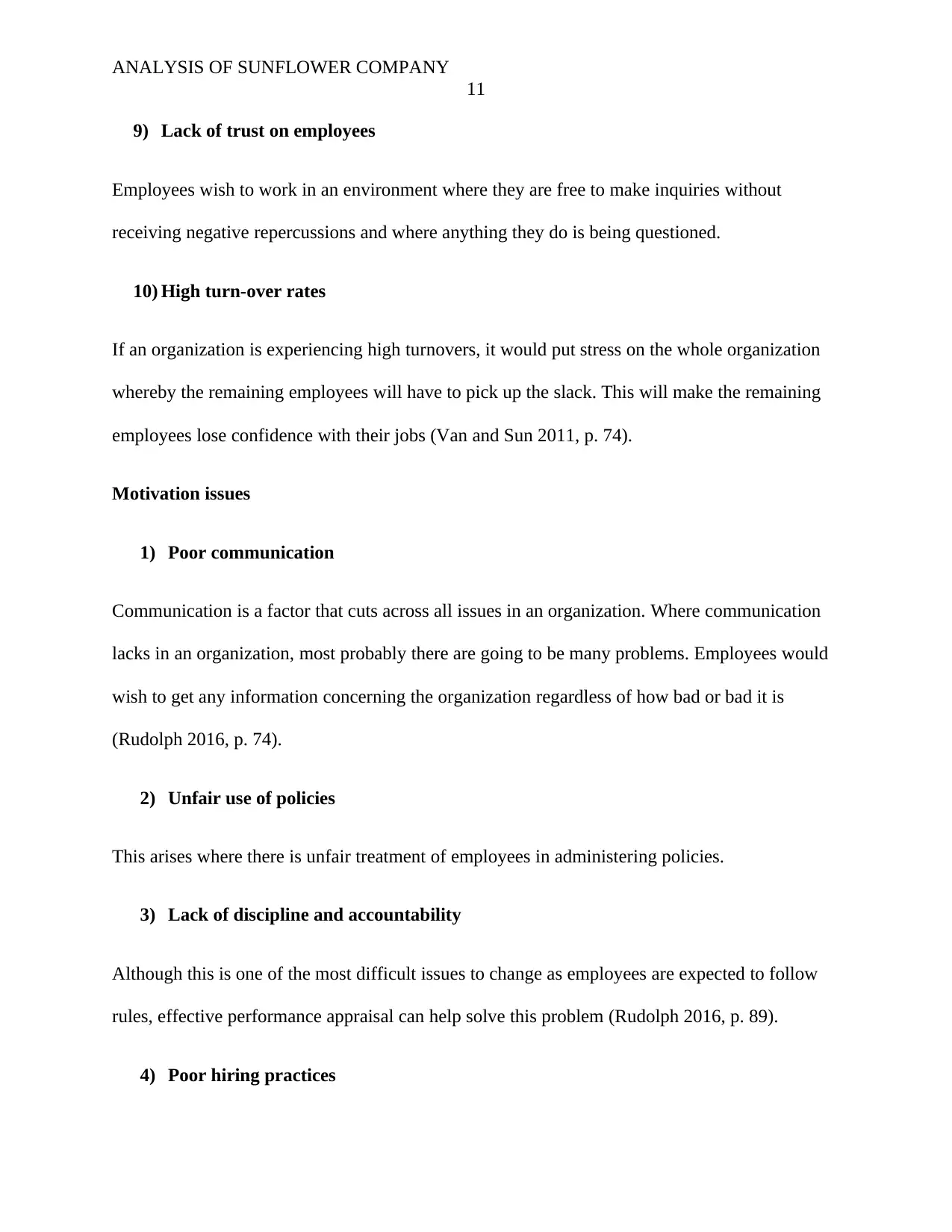
ANALYSIS OF SUNFLOWER COMPANY
11
9) Lack of trust on employees
Employees wish to work in an environment where they are free to make inquiries without
receiving negative repercussions and where anything they do is being questioned.
10) High turn-over rates
If an organization is experiencing high turnovers, it would put stress on the whole organization
whereby the remaining employees will have to pick up the slack. This will make the remaining
employees lose confidence with their jobs (Van and Sun 2011, p. 74).
Motivation issues
1) Poor communication
Communication is a factor that cuts across all issues in an organization. Where communication
lacks in an organization, most probably there are going to be many problems. Employees would
wish to get any information concerning the organization regardless of how bad or bad it is
(Rudolph 2016, p. 74).
2) Unfair use of policies
This arises where there is unfair treatment of employees in administering policies.
3) Lack of discipline and accountability
Although this is one of the most difficult issues to change as employees are expected to follow
rules, effective performance appraisal can help solve this problem (Rudolph 2016, p. 89).
4) Poor hiring practices
11
9) Lack of trust on employees
Employees wish to work in an environment where they are free to make inquiries without
receiving negative repercussions and where anything they do is being questioned.
10) High turn-over rates
If an organization is experiencing high turnovers, it would put stress on the whole organization
whereby the remaining employees will have to pick up the slack. This will make the remaining
employees lose confidence with their jobs (Van and Sun 2011, p. 74).
Motivation issues
1) Poor communication
Communication is a factor that cuts across all issues in an organization. Where communication
lacks in an organization, most probably there are going to be many problems. Employees would
wish to get any information concerning the organization regardless of how bad or bad it is
(Rudolph 2016, p. 74).
2) Unfair use of policies
This arises where there is unfair treatment of employees in administering policies.
3) Lack of discipline and accountability
Although this is one of the most difficult issues to change as employees are expected to follow
rules, effective performance appraisal can help solve this problem (Rudolph 2016, p. 89).
4) Poor hiring practices
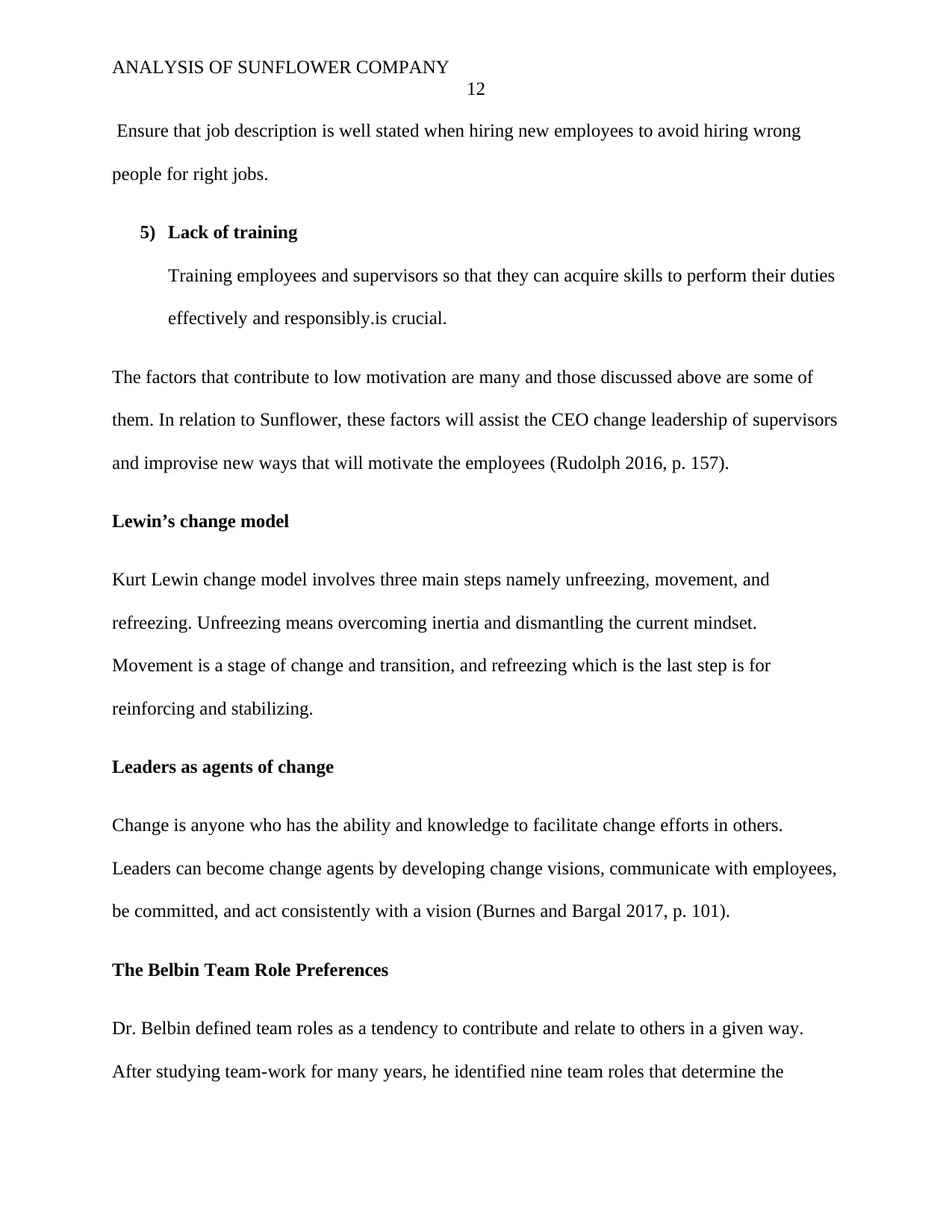
ANALYSIS OF SUNFLOWER COMPANY
12
Ensure that job description is well stated when hiring new employees to avoid hiring wrong
people for right jobs.
5) Lack of training
Training employees and supervisors so that they can acquire skills to perform their duties
effectively and responsibly.is crucial.
The factors that contribute to low motivation are many and those discussed above are some of
them. In relation to Sunflower, these factors will assist the CEO change leadership of supervisors
and improvise new ways that will motivate the employees (Rudolph 2016, p. 157).
Lewin’s change model
Kurt Lewin change model involves three main steps namely unfreezing, movement, and
refreezing. Unfreezing means overcoming inertia and dismantling the current mindset.
Movement is a stage of change and transition, and refreezing which is the last step is for
reinforcing and stabilizing.
Leaders as agents of change
Change is anyone who has the ability and knowledge to facilitate change efforts in others.
Leaders can become change agents by developing change visions, communicate with employees,
be committed, and act consistently with a vision (Burnes and Bargal 2017, p. 101).
The Belbin Team Role Preferences
Dr. Belbin defined team roles as a tendency to contribute and relate to others in a given way.
After studying team-work for many years, he identified nine team roles that determine the
12
Ensure that job description is well stated when hiring new employees to avoid hiring wrong
people for right jobs.
5) Lack of training
Training employees and supervisors so that they can acquire skills to perform their duties
effectively and responsibly.is crucial.
The factors that contribute to low motivation are many and those discussed above are some of
them. In relation to Sunflower, these factors will assist the CEO change leadership of supervisors
and improvise new ways that will motivate the employees (Rudolph 2016, p. 157).
Lewin’s change model
Kurt Lewin change model involves three main steps namely unfreezing, movement, and
refreezing. Unfreezing means overcoming inertia and dismantling the current mindset.
Movement is a stage of change and transition, and refreezing which is the last step is for
reinforcing and stabilizing.
Leaders as agents of change
Change is anyone who has the ability and knowledge to facilitate change efforts in others.
Leaders can become change agents by developing change visions, communicate with employees,
be committed, and act consistently with a vision (Burnes and Bargal 2017, p. 101).
The Belbin Team Role Preferences
Dr. Belbin defined team roles as a tendency to contribute and relate to others in a given way.
After studying team-work for many years, he identified nine team roles that determine the
⊘ This is a preview!⊘
Do you want full access?
Subscribe today to unlock all pages.

Trusted by 1+ million students worldwide
1 out of 20
Related Documents
Your All-in-One AI-Powered Toolkit for Academic Success.
+13062052269
info@desklib.com
Available 24*7 on WhatsApp / Email
![[object Object]](/_next/static/media/star-bottom.7253800d.svg)
Unlock your academic potential
Copyright © 2020–2025 A2Z Services. All Rights Reserved. Developed and managed by ZUCOL.





